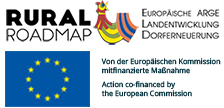Steinberg am Rofan, Tyrol, Austria
Steinberg am Rofan is situated 1,000 meters above sea level at the foot of the Rofan mountains. Achenkirch and the Achensee are less than ten kilometers away. The village has 287 inhabitants as a scattered settlement. After a heyday in terms of tourism in the 1970s with 350 guest beds and 30,000 overnight stays, there has been a very clear decline in tourism and thus the economy since the 1990s, as overnight stays have fallen to only around 12,000 per year.
In 2010, the community initiated a village renewal process that brought all residents together and involved them in a reorientation of village life. The old village center was revived as the first major project in 2016. The inn, which had been vacant for a number of years but was acquired by the municipality, was demolished and a village house with high-quality architecture was built on the same site. The state of Tyrol supported the project. Since it is questionable whether the community and the population could have raised their own share, a generous individual donation was a real stroke of luck for the village community. Because in addition to the new construction of the village house, the community center, an old courtyard that had been converted into the Mesnerhof-C as a co-working space, and the church were also embedded in the project in the years that followed. These four elements now form the new village center. Since the village house was largely made of wood, the community center and the Mesnerhof-C were also visually harmoniously adapted by renovating the outer facades with wood, thus creating a uniform overall picture that is characteristic of the scattered settlement.
The striving for sustainability is reflected in the energy supply in the use of renewable raw materials (pellets heating), compliance with low energy standards and the construction of PV systems.
Steinberg am Rofan sees its future in gentle tourism. The place has developed and received the quality seal of the “Mountaineering Village”. In order to meet the strict requirements, a mountaineering shop was set up in the town hall, which is freely accessible 24 hours a day, seven days a week and relies on the honesty of the visitors; a concept that has worked so far.
The villagers are aware that their settlement is peripheral and extensively affected by climate change. For example, the future of lifts is not assured. On the other hand, the place is also in the suburbs of Munich. Subsequently, the pressure on the real estate market is very high. For the purchase of second homes or holiday homes, however, the municipality has control instruments so that it can partially intervene here. This is managed very cleverly. At the same time, this proximity to an urban agglomeration also offers new opportunities. These include, for example, the “Munich mountain bus” of the German Alpine Association, which brings an average of 30 to 40 hikers to Steinberg per weekend in summer, or the high number of e-bike riders who come up from Lake Achensee in summer, drive to the village and subsequently bring important additional income to tenants of the village house.
Since the beginning of the process, citizen participation processes have been taking including new, innovative methods that have only been tested sporadically in other European regions so far. The first steps of planning took place with randomly selected villagers (according to the “citizen dialogue” model), or one-and-a-half-day citizens’ cafés were set up, which then presented the results to the entire population. In this context, a “Steinberg catalog of values” was adopted, which is considered to be a model for the future. Instead of project management, future projects should be developed based on values such as sustainability.
The social functioning of the place presents itself as very stable and sustainable. Some clubs can look back on long histories. With the fire station, built in 1992 and renovated in 2011, each club has had its own space for its activities since 2021. The rented village house not only offers restoration, but also a large, attractive meeting room, which is enlivened by a group of volunteers with various (village) events. A youth center has been added to the parish hall, where supervised group activities are offered on weekends. The high involvement of children and young people in the village and club activities is basically normalcy for such small villages.
Households in the town have had fiber optic connections since 2019, with the municipality making it compulsory to lay the lines from the street to every house and bearing the corresponding costs.
A former hotel is still empty in Steinberg am Rofan. The municipality oversees the process of takeover. In doing so, it follows the path of openness and transparency, even if the dialogue with the various interested parties proves to be difficult. The village can draw on its experiences from the moderation processes.
Farming is largely geared towards dairy farming and is mostly part-time. Almost a third of the farms are farmed biodynamically. There is no significant self-marketing. The village house could open up opportunities here. By tending the landscape, agriculture contributes to the intact landscape, which will probably be the greatest asset of the mountain village in the future.
With the luck of a generous donation for the village house, a good analysis and a clear vision, Steinberg am Rofan has implemented important projects for a sustainable future over the past 15 years. In doing so, the location saw both its peripheral location and the good connection to the city of Munich as an opportunity and made important decisions at the right time. The vision is sustainable and holistic. The moderation is extremely remarkable in its methodology and the results are exemplary in several areas.
Evaluated: 2022









